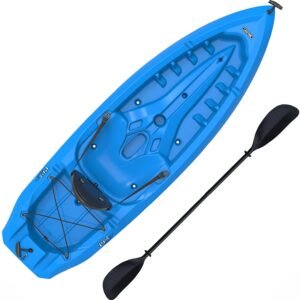You need to transport a kayak to a new, amazing spot, right?
If you are new to kayaking, you may have never thought about this important aspect of kayaking. While all the fun is in the water, you need to carefully think about how you will safely bring your boat to the kayaking spot.
Below, let’s overview kayak carrying methods which you may need to resort to before paddling.
Carrying a kayak alone
You won’t always have someone to carry your kayak with, so you need to know how to do it alone. Here’s what you need to do to carry your kayak:
- Stand on the left/right side of your kayak.
- Face the boat. Squat down and grab the edge of
the cockpit on your side with your both hands. Pull the edge of the kayak onto
your thighs. Make sure to bend with the knees and keep your back straight to
protect your joints from the load. - Reach the opposite edge of the kayak and grab
the underside of the cockpit. You may reach with either your left or right arm
depending on the kayak’s orientation and your preferences. - Stand up and lift your kayak onto your shoulder.
- Rest the rim of the cockpit on your shoulder.
You may wear your PFD to protect your shoulder from the hard surface of the
cockpit.
This method of solo carrying only works if the kayak is small and light enough. If you don’t have the strength to carry your kayak, then either opt for a kayak cart or carry with a buddy.
You may also drag your kayak on the ground, but only if your kayak’s hull is made from plastic. Fiberglass or composite hulls aren’t as abrasion-resistant as plastic, so they shouldn’t be dragged on the ground.
Carrying a kayak with someone else
Having a buddy to carry kayaks with is great. If you are going to paddle with someone else, then the carry portion of the journey won’t be at all difficult.
Here’s how to carry a kayak with a buddy:
- Place your and your buddy’s kayaks next to each
other. - Stand at the bow or stern of the kayaks and have
your buddy do the same at the opposite end of the vessels. You both should face
the direction you will be going. - Grab the handles of your and your buddy’s kayak.
Your buddy should do the same for the opposite end of the kayaks. - Pick the kayaks up, remembering to keep your
back straight and lift with your legs.
Transporting a kayak on a car roof
Transporting your kayak on the roof of a vehicle is your only choice for long-distance carrying. You need some additional equipment to make your car kayak-ready. Among the things that you may need are:
Crossbars. These run across the roof of your car. Usually, crossbars are attached to factory bars running from back to front of the roof. Most roof racks for kayaks require crossbars for installation. If you don’t have crossbars, you will either need to install them or look for a rack that doesn’t require crossbars.
Kayak rack. This is the accessory that you will be placing your kayak on. There are many kayak racks available out there, so if you don’t know how to choose the right one, have a look at our kayak rack guide.
If you will be transporting more than one kayak, then you may either need a second rack or a rack system that is designed to accommodate the desired number of boats.
Stacker bars. Stacker bars allow you to put your kayak onto its side. This can be especially helpful when carrying multiple kayaks. Some kayak racks may be able to carry your kayak in a vertical position, but if your rack doesn’t have such a feature, you’ll need to buy stacker bars separately.
Cam straps. Cam straps are designed to hold your kayak down against the roof of the vehicle. Usually, kayak racks come with a couple of straps, which is more than enough for most people. If your rack didn’t come with straps or if you need more, look for around 12 feet long straps.
Bow & stern lines. These are used to secure the bow and stern of the kayak. Usually, only 2 lines are necessary – one for the bow and the other for the stern. If your kayak is very long though, you may need to use more lines.
Again, some kayak racks may include bow & stern lines, but if they don’t, you’ll need to get them separately.
Loading a kayak onto the roof
Once you’ve got your kayak carrier set up on the roof of your car, you’ll need to load the kayak onto it. This is perhaps the least favorite step for any kayaker since it’s a bit difficult but perfectly doable with the right equipment or with a buddy.
Alone
Perhaps the easiest way of loading your kayak onto the roof is just shoving it up there with bare power. However, if you don’t have the strength to lift your kayak up, you will need to go for other methods.
Lift system. If you are ready to spend a little more money on loading assistance, then the way to go is a lift system. Lift systems usually slide from the top of your car down to the side to make loading the kayak onto the roof easier. Thanks to such a design, you only need to strap your kayak to the lift system and lift the rack up onto the roof.
Rolling wheels. Some kayak racks have rolling wheels that allow you to slide your kayak onto the roof. You still need to have some strength to use this system – you need to lift the bow of the kayak up, set it into the rack’s rear cradle, and then roll the kayak forward.
Racks with rolling wheels are less expensive than lift systems, but they do require some amount of force from you.
Towel. You may use a towel or blanket to assist you with lifting the kayak up onto the roof of your car. This method’s purpose is to imitate racks with rolling wheels.
Place a towel on the rear of your vehicle’s roof. Lift the bow of your kayak up and place it onto the towel. Then, push the kayak forward to set it onto the rack.
No matter which method you use, make sure that the kayak is centered between the crossbars and is parallel to your car. This is necessary for secure strapping.
With a buddy
It’s relatively easy to load a kayak onto a car’s roof with a buddy. Here’s how to do it:
- Position the kayak next and parallel to your
car. Keep the bow toward the car’s front. - Grab the kayak by the hull (not the handles) and
lift it overhead. Again, lift with your legs and keep your back straight. - Bring the kayak directly above the rack.
- Gently set the kayak down onto the rack.
- Again, ensure that your kayak is centered
between the crossbars and is parallel to the vehicle.
Strapping a kayak down to the roof
When transporting your kayak on the roof of a car, you will need to strap it down to make sure that it stays in place during the trip.
Below is a step-by-step guide on tying a kayak down onto a car roof:
- You may use regular rope or cam straps to tie
your kayak to your car. The beauty of cam straps is that they don’t require you
to use any knots. With ropes, you will need to learn how to do proper knots. - Position the buckle of the cam strap (or the end
of the rope if you are using one) to the side of the kayak a little above the
crossbars. - Toss the strap’s other end over the kayak to the
opposite side of your car. Walk around your car to the end you’ve just tossed
over, grab it, and loop it underneath the crossbar. - Toss the strap’s end back over the kayak. Again,
walk around the car and loop the strap’s end over the crossbar. - Do the same for the other crossbar.
You want to ensure that you place the straps on either side of the kayak’s widest part. The straps will as if embrace the kayak by its thickest area, not allowing it to slide forward or backward.
When tightening the straps around your kayak, make sure to be extra careful. A plastic kayak can deform if you tie it down too tight, while fiberglass or composite kayaks may crack from too much pressure. The straps need to be tight just enough to prevent the kayak from moving around.
If the cam straps are long and you’ve left any loose ends, tie them to the crossbars to make sure that they don’t flap around while you drive.
Tying with bow & stern lines
For extra safety, you may also tie your kayak down with bow & stern lines. This isn’t mandatory, but if you have a heavy kayak or if you will be driving fast on a highway, it may be a good idea to use bow & stern lines.
You may tie the lines to the bumpers of your vehicle. Alternatively, you may tie your kayak to a tow hook or a hood loop strap. On the kayak, hook the line to a secure point, e.g. the carry handle. And again, ensure that the lines sit snug and not too tight.
Bottom line
Properly transporting your kayak to the kayaking spot is perhaps the most crucial part of your journey. To have a fun and safe experience, you need to ensure that your kayak reaches the destination without damage. Aside from that, you don’t want to strain your back while carrying your boat.
The tips overviewed above should be enough for safe kayak transport. Make sure to do everything properly and stay safe during your trip!


